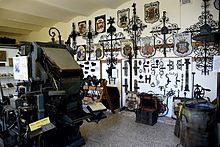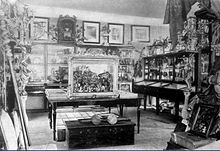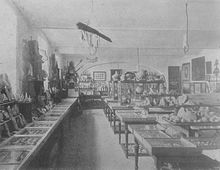Kaiser Franz Josef Museum
The Kaiser-Franz-Josef-Museum is a museum on the edge of the Vienna Woods in Baden near Vienna in Lower Austria . The historical collections of the museum mainly consist of folkloric objects and handicrafts as well as objects of everyday culture, most of which were created in Lower Austria. There is also a considerable historical collection of cutlery , a collection of religious folk art , a collection of historical weapons and uniforms and a small collection of objects from pre-industrial criminal justice.
Prehistory, founding of the association
On December 19, 1893, the local researchers Carl Calliano (1857–1934), Gustav Calliano (1853–1930), Anton Schiestl (1873–1933) and Johann Wagenhofer (1870–1922) founded the association “Niederösterreichische Landesfreunde” in Baden . The activities of the association extended broadly to the research of the history of the state of Lower Austria. Above all, the association's publication “Der Niederösterreichische Landesfreund” made the history of the country accessible to broader strata of the population in a generally understandable way. The association was founded in the era of historicism ; At that time, comparatively broad sections of the population were euphoric about history.
The association "Niederösterreichische Landesfreunde" also earned merits through its excavations in the area around Baden. The prehistoric finds recovered during these excavations acquired scientific significance under the technical name of Baden culture .
After the association's collections became more and more extensive, the association's management began looking for a suitable building to accommodate them. Finally, the collections, which included numerous prehistoric and Roman objects, were placed in the basement of the newly built high school in Baden's Biondekgasse. On November 4, 1900, the exhibition space was opened to the public.
History, collections
As the basement bar in the Biondekgasse grammar school soon proved to be inadequate, especially since essential parts of the collections could not be properly housed, the plan arose to build a separate building for the association's collections. Carl Calliano left the building site free of charge to the association for the purpose of the new museum building on Baden's Mitterberg, and other association members provided funding. Zeno Gögl (1853–1932), the landlord and member of the Lower Austrian state parliament, who was resident in Dornau and was able to obtain a sum of 4,000 crowns from the Ministry of Education through his political connections, played a special role in founding the museum . In addition, Zeno Gögl, who joined the club in 1901, contributed a further 4000 crowns from his own pocket. The plans for the museum building come from the architects Karl Reiner and Karl Badstieber .
On September 8, 1905, the "Museum of the Lower Austrian Regional Friends in Baden" was opened. The owners of the objects transferred a large part of their collections to the museum. The one-story building housed three halls that were named after personalities who had made a special contribution to the establishment of the museum. The “Zeno-Gögl-Saal” on the ground floor, named after the main benefactor, contained a rich collection of prehistoric and Roman finds. In the "Dr.-Wilhelm-Ritter-von-Hartel-Saal" on the first floor, named after the then Minister of Education Wilhelm August Ritter von Hartel (1839–1907), mainly ethnographic objects were found. The third room on the first floor was named "Johann-Schiestl-Saal" after the Baden patronage commissioner and house owner Johann Schiestl (1838–1904), the father of Anton Schiestl, who donated his Badensia collection to the museum. It contained products from traders in Baden as well as a rich collection of coins and household appliances. After the opening of the museum, the population of Baden presented themselves with a variety of benefits in kind, so that the folklore department grew threefold within two years.
The 60th anniversary of the reign of Emperor Franz Joseph I in 1908 was the reason to dedicate the museum to the monarch. In the course of this, the decision was made to add a newly built "Kaiser Jubilee Hall" to the existing museum. It was also decided to document the reign of Emperor Franz Joseph I and the development of the spa town of Baden from 1848 to 1908 with appropriate exhibits. On September 27, 1908, the "Kaiser Jubilee Hall" was officially opened. Another (fifth) exhibition hall was added the following year.
On October 20, 1909, the curator of the Imperial Academy of Sciences, Archduke Rainer , appeared on horseback at the museum and viewed the collections. On October 25, 1909, on the basis of an imperial authorization, the name “Kaiser-Franz-Josef-Museum” was given.
In September 1916, the museum founding association "Niederösterreichische Landesfreunde" advertised the construction of an extension as a hall of honor and fame , as a local sanctuary , which should continually remind of the difficult times of the years 1914 to 1916.
The collections were subsequently increased even further. In 1939, the Baden lieutenant in the reserve, Julius Schopf, gave the museum his collection of around 2,000 objects, including the marshal's coat of Emperor Franz Joseph I from 1902 and the gala uniform of Colonel General Archduke Joseph Ferdinand .
After the museum survived the Second World War unscathed, it suffered severe devastation immediately after the war. The museum's furnishings were smashed and a significant part of the museum's objects destroyed, damaged or stolen. Soviet occupation soldiers deliberately destroyed mainly parts of the militaria collection.
After the occupation, the museum was closed for a long time. The remaining objects from the prehistoric and Roman collections have now been given to the Rollett Museum in Baden . On September 6, 1965, the house, which was now largely furnished with folklore objects and handicraft products, was reopened under the name "Kaiser-Franz-Josef-Museum für Handwerk und Volkskunst". The remains of the "Wolfgang Schopf Weapons and Uniforms Collection" were placed in a separate room on the ground floor. A hall on the first floor was set up as a sacred hall. In 1987, a collection of cutlery from the Baroque and Biedermeier periods was donated.
In the wake of the 100th anniversary in 2005, on the occasion of which a commemorative publication was published, the museum was renamed back to "Kaiser-Franz-Josef-Museum". In 2008 a new “Imperial Hall” was dedicated to the former members of the imperial family with ties to the spa town of Baden in the 19th and 20th centuries on the first floor. In June 2012, the commercial hall (Dr. Wilhelm Ritter von Hartel hall) and the sacral hall were redesigned as further innovations.
Special exhibitions
- 1987: " Marian pilgrimage in Austria then and now" (with catalog)
- 1990: "Baden naiv" - reverse glass paintings by the Baden artist Ingrid Urschitz
- 1990: “Painter from Passion”, Walter Kovar exhibition
- 1993: "The Austrian Match ", special exhibition on the occasion of the anniversary "100 Years of Friends of Lower Austria in Baden"
- 1993: Impressions from Greece , exhibition by the Athens painter Tassos Yannopoulos
- 1994: "Snappy cartoons - excellent portraits", exhibition of the coroner and self-taught Johann Missliwetz
- 1995: silk paintings, exhibition by Elfriede Mach
- 1996: “Color landscapes”, exhibition by Edwin Nemetz and Ferdinand Sabary
- 1999: "The history of tobacco "
- after 1999: "Franz Josef and the tobacco"
further activities
Advent markets have been held in the area of the Kaiser-Franz-Josef-Museum since the 1990s . In addition, there were readings and concerts in the museum again and again. On July 12, 1991, a Szekler gate in front of the museum was handed over to the city of Baden. The donation from the town of Székely-Udvarhely in the Szeklerland was made in gratitude for the Baden “aid program for Romania ”. By 2004, a group of students from the University of Vienna created an exact inventory of the objects. The inventory has been kept up-to-date ever since. The museum takes part in the Long Night of the Museums every year.
literature
- Opening of the Museum of Friends of the Country . In: "Badener Zeitung" of September 9, 1905, p. 3.
- Johann Wagenhofer: Guide through the Kaiser Franz Josef Museum and through the spa town of Baden , publisher of the Association of Lower Austrian Regional Friends in Baden, Baden 1910.
- Roxane Cuvay: Guide through the Kaiser-Franz-Josef-Museum Baden , ed. from the association "Niederösterreichische Landesfreunde", Baden 1965.
- Guide through the documentation "Marien-Pilfahrt in Österreich" once and now in the Kaiser-Franz-Josef-Museum in Baden near Vienna , ed. from the association "Niederösterreichische Landesfreunde", Baden 1987.
- Raimar Wieser and Carl H. Bernaschek: 100 years of the Kaiser Franz Josef Museum in Baden near Vienna. Museum of Crafts and Folk Art, Festschrift , ed. from the Association of Friends of Lower Austria in Baden, Heimat Verlag, Baden 2005.
- Johann Werfring: A cozy cosmos in the “Hochzeit-Kastl” In: “Wiener Zeitung” from April 26, 2012, supplement “ProgrammPoints”, p. 7.
- Edith Lappel: Kaiser Franz Josef Museum in a new guise. In: "Badener Zeitung" of July 12, 2012, p. 24.
- Johann Werfring: About grape thieves, donkeys and biting cats In: “Wiener Zeitung” of September 20, 2012, supplement “ProgrammPoints”, p. 7.
- Johann Werfring: Historicism with a heart in Baden near Vienna In: “Wiener Zeitung” of May 8, 2013, supplement “ProgrammPunkte”, p. 7.
Individual evidence
- ↑ Life data according to documentation in the Kaiser-Franz-Josef-Museum.
- ↑ Roxane Cuvay: Guide to the Kaiser-Franz-Josef-Museum Baden, ed. from the association "Niederösterreichische Landesfreunde", Baden 1965, p. 5.
- ^ Raimar Wieser and Carl H. Bernaschek: 100 Years of the Emperor Franz Josef Museum Baden near Vienna. Museum of Crafts and Folk Art, Festschrift, ed. from the Association of Friends of Lower Austria in Baden, Heimat Verlag, Baden 2005, p. 7f.
- ^ Johann Werfring: Historicism with a heart in Baden near Vienna In: "Wiener Zeitung" of May 8, 2013, supplement "ProgrammPunkte", p. 7.
- ↑ Roxane Cuvay: Guide to the Kaiser-Franz-Josef-Museum, 5.
- ^ Raimar Wieser and Carl H. Bernaschek: 100 Years, p. 11.
- ↑ Raimar Wieser and Carl H. Bernaschek: 100 years, p. 11f.
- ↑ Roxane Cuvay: Guide to the Kaiser-Franz-Josef-Museum, 5.
- ↑ While Roxane Cuvay as well as Raimar Wieser and Carl H. Bernaschek state the founding date as September 8, 1905, Johann Wagenhofer noted this as September 8, 1904 in his museum guide. Cf. Roxane Cuvay: Guide through the Kaiser-Franz-Josef-Museum, p. 5; Raimar Wieser and Carl H. Bernaschek: 100 Years, p. 14; Johann Wagenhofer: Guide through the Kaiser Franz Josef Museum and through the spa town of Baden, publishing house of the Association of Lower Austrian Regional Friends in Baden, Baden 1910, p. 28. The correct opening date is September 8, 1905, which was confirmed by a report in the “Badener Newspaper "is occupied. See opening of the Museum of Friends of the Land. In: "Badener Zeitung" of September 9, 1905, p. 3.
- ^ Raimar Wieser and Carl H. Bernaschek: 100 Years, pp. 14 and 16.
- ↑ Roxane Cuvay: Guide to the Kaiser-Franz-Josef-Museum, 5.
- ^ Johann Wagenhofer: Guide through the Kaiser Franz Josef Museum, p. 28.
- ^ Raimar Wieser and Carl H. Bernaschek: 100 years, p. 15f.
- ↑ Roxane Cuvay: Guide to the Kaiser-Franz-Josef-Museum, 5.
- ↑ Raimar Wieser and Carl H. Bernaschek: 100 Years, pp. 16-18.
- ^ Carl Calliano (Red.): Baden in the field of honor 1914-1916. IX. War number of the "Badener Stadtgeschichtlichen Blätter". Official organ of the "Familien-Chronik" association in Baden (ed.). September 1915, p. 67 f.
- ↑ Raimar Wieser and Carl H. Bernaschek: 100 Years, p. 26.
- ↑ Roxane Cuvay: Guide to the Kaiser-Franz-Josef-Museum, p. 6
- ^ Raimar Wieser and Carl H. Bernaschek: 100 years, p. 27f.
- ^ Raimar Wieser and Carl H. Bernaschek: 100 years, p. 28f.
- ↑ Raimar Wieser and Carl H. Bernaschek: 100 Years, p. 34.
- ^ Edith Lappel: Emperor Franz Josef Museum in a new guise. In: "Badener Zeitung" of July 12, 2012, p. 24.
- ↑ A large number of the objects from the Dr.-Wilhelm-Ritter-von-Hartel-Saal came to the depot in the course of this redesign. For the former furnishings of the Dr. Wilhelm Ritter von Hartel Hall, cf. Roxane Cuvay: Guide to the Kaiser-Franz-Josef-Museum, pp. 14–20 as well as Raimar Wieser and Carl H. Bernaschek: 100 Years, pp. 29f. and p. 42.
- ^ Association: "History" on the museum website ( Memento of the original from September 24, 2013 in the Internet Archive ) Info: The archive link was automatically inserted and not yet checked. Please check the original and archive link according to the instructions and then remove this notice.
- ↑ Raimar Wieser and Carl H. Bernaschek: 100 Years, pp. 37–40.
Web links
- Website of the Kaiser-Franz-Josef-Museum
- Kaiser-Franz-Josef-Museum on the website of the municipality of Baden near Vienna
- Excavations of the Calliano brothers in the royal cave of Baden In: Ernst Probst: Die Litzenkeramik or Draßburger culture in Austria. A Bronze Age culture from around 2000 to 1600 BC Chr. , Grin Verlag, Munich 2011, p. 31f.
Coordinates: 48 ° 0 ′ 59.8 ″ N , 16 ° 13 ′ 23.8 ″ E







